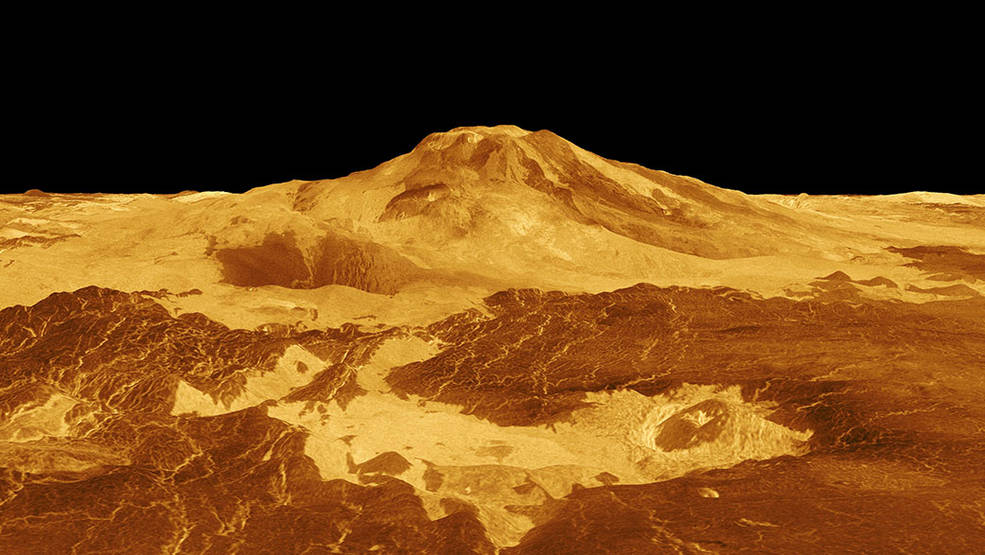
Venus had a lot going for it. Roughly the same diameter and density as Earth, it orbits in the solar system’s habitable zone—just the right distance from the sun for liquid water to exist. But the planet’s biological prospects were long ago wrecked by a runaway greenhouse effect that left it with an atmosphere that is 95% carbon dioxide, and 90 times the pressure of Earth’s—the equivalent of being a mile deep in the ocean. Venus’s surface temperatures hover at about 475º C (900º F), or hot enough to melt lead.
But there is one fiery feature of Earth that Venus has long been thought to lack: volcanoes. Without the plate tectonics that drive eruptions on Earth, Venus has been said to be a volcanically quiescent place, having seen its last blast perhaps a billion years ago. Or so it seemed. Now, however, a new paper in Science reveals modern-day volcanic activity on Venus—a discovery that may cause scientists to reconsider how rocky planets like Earth form and even help us look for habitable worlds surrounding other stars.
The new findings rely on a fresh look at images captured of Venus by NASA’s Magellan spacecraft, which orbited the planet taking radar soundings of its surface from 1990 to 1994. Overall, Magellan mapped more than 40% of Venus’s face—capturing images that at the time, were stored on DVDs, and shipped to various astronomy labs in cardboard boxes. Now the Magellan images are available to researchers online. Robert Herrick, planetary scientist at the University of Alaska, Fairbanks, and Scott Hensley, senior research scientist at NASA’s Jet Propulsion Laboratory in Pasadena, Calif., took advantage of that fact to give the 30-year-old images a second look.
More from TIME
The area that attracted their attention is a region known as Alta Regio, near the Venusian equator, that is home to the planet’s two largest dormant volcanoes: Ozza Mons and Maat Mons. What the researchers were looking for were any signs that there still might be residual volcanic activity associated with the giant vents. The mere lack of plate tectonics would not necessarily rule that out: Venus is still rich in subsurface radioactive material that could provide the heat needed to produce an eruption.
Hensley and Herrick scrutinized images taken eight months apart—between February 1991 and October 1991—and after about 200 hours of study, they hit paydirt. One small, circular vent associated with Maat Mons that, in the February image, measured 2.2 sq. km (1 sq. mi.), had doubled its size and become kidney shaped in the October image. “The vent is nearly filled to its rim in the [second] image,” the researchers wrote in their paper. “We speculate that a lava lake formed during the 8-month gap between images.”
But “speculate” was a key word. During the two passes Magellan made over the Alta Regio region, it took its radar soundings of the target vent from different angles. It was always thus possible that the seeming change in the size and shape of the vent was just a result of a change in perspective. The researchers thus ran hundreds of computer simulations of the twin images, trying to determine if it was possible to reproduce the change they had seen through mere shifts in angle of sight. But the tests came up empty.
“The simulation cannot reproduce the vent’s kidney shape,” Hensley and Herrick wrote. “We definitely conclude that the vent has changed.”
Where there is one volcano, there should be more—perhaps many more. The researchers studied just 1.5% of Venus’s surface in their 200 hours of image comparisons and they plan to dive back into the three-decade-old pictures for more. “While this is just one data point for an entire planet,” Hensley said in a statement released by NASA, “it confirms there is modern geological activity [on Venus].”
That has implications that go beyond just one planet in our own familiar solar system. More than 5,000 exoplanets have been spotted in our galaxy alone and the true jackpot discoveries are small, rocky worlds with a solid surface where life could take hold. Venus, Earth, and Mars all check that box, and all orbit in the habitable zone. But only Earth caught all of the lucky breaks to become the garden world that it is. The better we grasp how such planets form, the better we will know where else to go looking for life.
“A bunch of big-picture scenarios have been put forth to explain why Earth and Venus are so different now,” wrote Herrick in an email to TIME, “including some that have Venus as habitable with something like plate tectonics for three quarters of its history. In terms of bigger picture ideas, the evolution of Venus and Mars through time will shape our ideas about what controls where the habitable zone is around other stars in other solar systems.”
“Resolving questions like [the evolution of Venus],” Hensley added in an email to TIME, “will provide clues to rocky planets’ evolution more generally and which one may be habitable or not.”
The search for life in the cosmos goes on. The new findings from so close to home advance that effort at least one small step.
More Must-Reads from TIME
- Cybersecurity Experts Are Sounding the Alarm on DOGE
- Meet the 2025 Women of the Year
- The Harsh Truth About Disability Inclusion
- Why Do More Young Adults Have Cancer?
- Colman Domingo Leads With Radical Love
- How to Get Better at Doing Things Alone
- Michelle Zauner Stares Down the Darkness
Write to Jeffrey Kluger at jeffrey.kluger@time.com